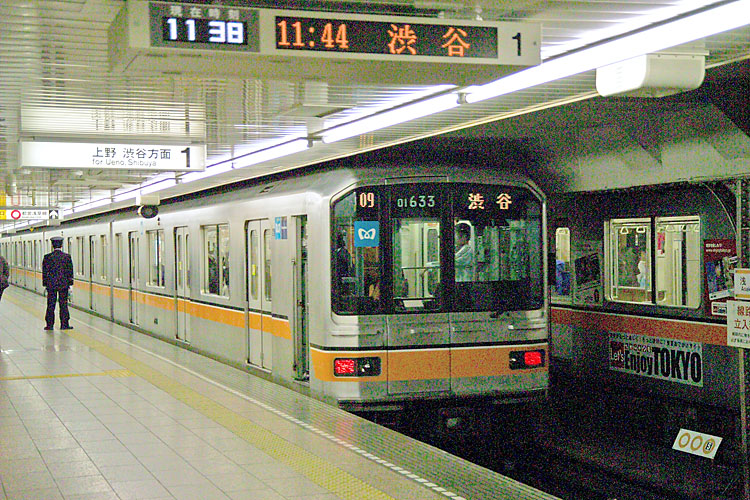Tōkyō Metro 10000 series — Infobox EMU name = Tōkyō Metro 10000 series imagesize = 240px background=#BA6832 caption = 10000 series set 10101 at Shinkiba depot, December 2006 InService = 2006 Present Manufacturer = Hitachi Family = A train Built = Under Delivery… … Wikipedia
Tōkyō Metro 02 series — Infobox EMU name = Tōkyō Metro 02 series imagesize = 240px background = caption = 02 series train on Marunouchi Line Hōnanchō Branch InService = 1988 Present Manufacturer = Family = Built = 336 vehicles (59 sets) Refurbishment = Formation = 3/6… … Wikipedia
Tōkyō Metro 9000 series — Infobox EMU name = Tōkyō Metro 9000 series imagesize = 250px caption = Series 9000 train on the Namboku Line, Tokyo Metro InService = 1991 Present Manufacturer = Kawasaki Heavy Industries, Nippon Sharyo, Tokyu Car background = #339992 Family =… … Wikipedia
Tōkyō Metro 05 series — Infobox EMU name = Tōkyō Metro 05 series imagesize = 240px background = caption = Set 05 102, one of the original 05 series trains InService = 1988 Present Manufacturer = Family = Built = 430 vehicles (43 sets) Refurbishment = Formation = 10 cars … Wikipedia
Tōkyō Metro 06 series — Infobox EMU name = Tōkyō Metro 06 series imagesize = 240px caption = 06 series train at Mukōgaoka Yūen on the Odakyū Odawara Line, June 2006 InService = 1993 Present background = #00A650 Manufacturer = Family = Built = 1 set (10 vehicles)… … Wikipedia
Tōkyō Metro 6000 series — Infobox EMU name = Tōkyō Metro 6000 series imagesize = 240px caption = 6000 series train at Shin Yurigaoka on the Odakyū Odawara Line, June 2006 InService = 1967 Present background = #00A650 Manufacturer = Family = Built = 36 sets (353 vehicles)… … Wikipedia
Tōkyō Metro 7000 series — Infobox EMU name = Tōkyō Metro 7000 series imagesize = 240px caption = 7000 series set 7134 on the Seibu Ikebukuro Line background= #E5D100 InService = 1974 Present Manufacturer = Family = Built = 340 vehicles Refurbishment = Formation = 8/10… … Wikipedia
Tōkyō Metro 08 series — Infobox EMU name = Tōkyō Metro 08 series imagesize = 240px background = caption = Hanzōmon Line 08 series InService = 2003 Present Manufacturer = Nippon Sharyō Family = Built = 60 vehicles (6 sets) Refurbishment = Formation = 10 cars per trainset … Wikipedia
Tōkyō Metro 07 series — Infobox EMU name = Tōkyō Metro 07 series imagesize = 240px background = caption = Tōzai Line 07 series set at Fukukawa Depot, January 2007 InService = 1992 Present Manufacturer = Family = Built = 60 vehicles (6 sets) Refurbishment = Formation =… … Wikipedia
Tōkyō Metro 03 series — Infobox EMU name = Tōkyō Metro 03 series imagesize = 240px background = caption = 03 series train InService = 1988 Present Manufacturer = Family = Built = 336 vehicles (42 sets) Refurbishment = Formation = 8 cars per trainset Operator = Tokyo… … Wikipedia

